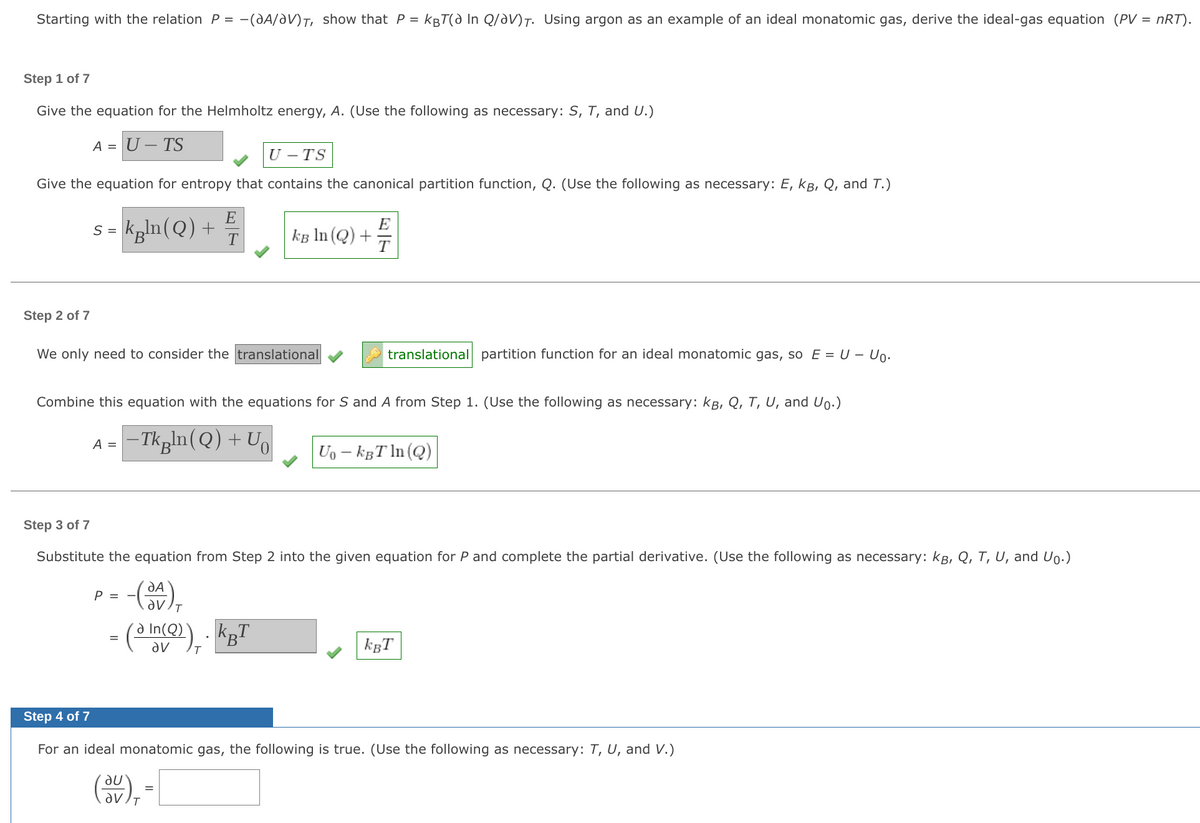Chemistry: Principles and Practice
3rd Edition
ISBN:9780534420123
Author:Daniel L. Reger, Scott R. Goode, David W. Ball, Edward Mercer
Publisher:Daniel L. Reger, Scott R. Goode, David W. Ball, Edward Mercer
Chapter5: Thermochemistry
Section: Chapter Questions
Problem 5.101QE: In the 1880s, Frederick Trouton noted that the enthalpy of vaporization of 1 mol pure liquid is...
Related questions
Question
100%

Transcribed Image Text:Starting with the relation P = -(A/V), show that P = kBT(à In Q/V). Using argon as an example of an ideal monatomic gas, derive the ideal-gas equation (PV = nRT).
Step 1 of 7
Give the equation for the Helmholtz energy, A. (Use the following as necessary: S, T, and U.)
A = U-TS
U-TS
Give the equation for entropy that contains the canonical partition function, Q. (Use the following as necessary: E, KB, Q, and T.)
S =
kpln(Q) +
E
T
kB ln (Q) +
FR
Step 2 of 7
We only need to consider the translational
translational partition function for an ideal monatomic gas, so E = U - Uo.
Combine this equation with the equations for S and A from Step 1. (Use the following as necessary: KB, Q, T, U, and U₁.)
A = -Tkaln(Q) + U₁
0
U₁ - kBT ln(Q)
Step 3 of 7
Substitute the equation from Step 2 into the given equation for P and complete the partial derivative. (Use the following as necessary: KB, Q, T, U, and Up.)
P =
-(SA),
.
- (a In(@)); *
kpT
=
B
КВТ
Step 4 of 7
For an ideal monatomic gas, the following is true. (Use the following as necessary: T, U, and V.)
(3V) ₁ =
T
Expert Solution
This question has been solved!
Explore an expertly crafted, step-by-step solution for a thorough understanding of key concepts.
Step by step
Solved in 3 steps with 1 images

Knowledge Booster
Learn more about
Need a deep-dive on the concept behind this application? Look no further. Learn more about this topic, chemistry and related others by exploring similar questions and additional content below.Recommended textbooks for you

Chemistry: Principles and Practice
Chemistry
ISBN:
9780534420123
Author:
Daniel L. Reger, Scott R. Goode, David W. Ball, Edward Mercer
Publisher:
Cengage Learning

Chemistry: The Molecular Science
Chemistry
ISBN:
9781285199047
Author:
John W. Moore, Conrad L. Stanitski
Publisher:
Cengage Learning

Physical Chemistry
Chemistry
ISBN:
9781133958437
Author:
Ball, David W. (david Warren), BAER, Tomas
Publisher:
Wadsworth Cengage Learning,

Chemistry: Principles and Practice
Chemistry
ISBN:
9780534420123
Author:
Daniel L. Reger, Scott R. Goode, David W. Ball, Edward Mercer
Publisher:
Cengage Learning

Chemistry: The Molecular Science
Chemistry
ISBN:
9781285199047
Author:
John W. Moore, Conrad L. Stanitski
Publisher:
Cengage Learning

Physical Chemistry
Chemistry
ISBN:
9781133958437
Author:
Ball, David W. (david Warren), BAER, Tomas
Publisher:
Wadsworth Cengage Learning,

Chemistry: Principles and Reactions
Chemistry
ISBN:
9781305079373
Author:
William L. Masterton, Cecile N. Hurley
Publisher:
Cengage Learning

Chemistry
Chemistry
ISBN:
9781305957404
Author:
Steven S. Zumdahl, Susan A. Zumdahl, Donald J. DeCoste
Publisher:
Cengage Learning

Chemistry: An Atoms First Approach
Chemistry
ISBN:
9781305079243
Author:
Steven S. Zumdahl, Susan A. Zumdahl
Publisher:
Cengage Learning